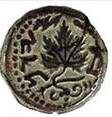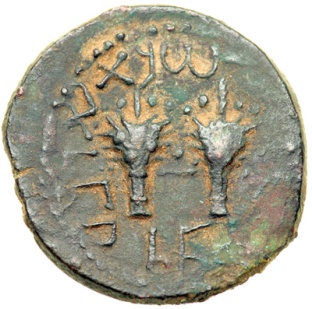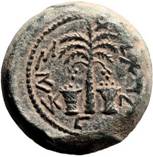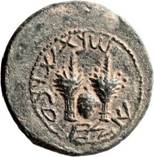| |
When
the Jewish Revolt broke out in 66 CE, the revolutionaries quickly captured
the holy city of Jerusalem, thus assuring them access to the great Temple
for religious purposes and to its vast treasury as well. From the silver
therein - presumably consisting of Tyrian coins paid in taxes over the years
- they struck the most famous of all Jewish coins - in shekel and half shekel
denominations. These handsome coins are the first truly Jewish silver coins.
They feature a chalice on one side with the year of the revolt above, surrounded
by the ancient Hebrew inscription "Shekel of Israel." Three budding pomegranates
are featured on the reverse, with the inscription "Jerusalem the Holy."
Two examples of prototype designs, with a row of dots encircling the symbols,
are known. (#60) Prototype quarter shekels were also produced in the first
(#63) and fourth years (#69A) of the revolt. Unique in ancient numismatics,
the edge of each shekel and half shekel was hammered, creating multiple
flat facets (except for year 1 coins). Year 1 (66/67 CE) Jewish shekels
(#61) and half shekels (#62) are scarce, year 2 (67/68 CE) shekels (#64)
and half shekels (#65) and year 3 (68/69 CE) shekels (#66) and half shekels
(#67) are relatively common, year 4 (69/70 CE) shekels (#68) and half shekels
(#69) and year 5 (70 CE) shekels (#70) are extremely rare.

#60 - First Revolt shekel prototype, Year 1 (H-1352)

#61 - First Revolt shekel, Year 1 (H-1353)

#62 - First Revolt half shekel, Year 1 (H-1355)

#63 - First Revolt quarter shekel prototype, Year 1 (H-1356)

#64 - First Revolt shekel, Year 2 (H-1358)

#65 - First Revolt half shekel, Year 2 (H-1359)

#66 - First Revolt shekel, Year 3 (H-1361)

#67 - First Revolt half shekel, Year 3 (H-1362)

#68 - First Revolt shekel, Year 4 (H-1364)

#69 - First Revolt half shekel, Year 4 (H-1365)

#69A - First Revolt quarter shekel prototype, Year 4 (H-1366)

#70 - First Revolt shekel, Year 5 (H-1370)

#70A - First Revolt half shekel, Year 5 (H-1371)
Bronze prutahs were issued in the second (#71) and third (#72) years of
the revolt. They feature an amphora (uncovered on year 2, with a pointed
cover on year 3), with the date and poignant Hebrew inscription "The Deliverance
of Zion."
 
#71 - First Revolt prutah, Year 2 (H-1360)

#72 - First Revolt prutah, Year 3 (H-1363)
Finally, there are three sizes of larger bronze coins, minted in the fourth
year of the revolt, presumably when the supply of silver was running low.
The smallest does not have a denomination indicated, but is usually referred
to as an Eighth (Shekel?). It is assumed that all of these denominations
are fractions of a shekel. Like the silver coins, a chalice is featured,
along with symbols of the harvest festival of Succoth - lulav (bunch of
branches) and etrog (lime-like fruit). The date and inscription "For the
Redemption of Zion" are inscribed. (#73) The medium bronze has the same
inscriptions, with the denomination "Reva" (Quarter) indicated; a large
etrog is depicted on the obverse, and two lulav are shown on the reverse.
(#74) The largest bronze coins are inscribed "Chatzi" (Half); again the
lulav and etrog are pictured on one side, with a palm tree and baskets on
the reverse. (#75)
 
#73 - First Revolt eighth?, Year 4 (H-1369)
 
#74 - First Revolt quarter, Year 4 (H-1368)
 
#75 - First Revolt half, Year 4 (H-1367)
© 2020-Mel Wacks
|





















